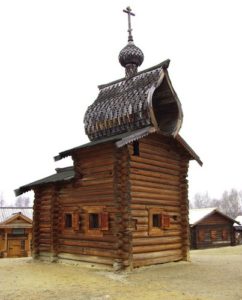This is a popular stop for tourists on the way from Irkutsk to Listvyanka. It is a pleasant drive through open woodland. At the end of April it was still bitterly cold and there was snow lying on the ground.
Over 40 old wooden buildings from the 17th-19thC have been rebuilt here and reflect the Russian and Buryat cultures.
There is little information about this on the web and very little written information at the museum.
There is a restored 19thC estate farm surrounded by a wooden palisade with outbuildings and sauna. Outside the yard was divided into clean (for machinery and sleighs and dirty areas (for animals). Inside the building was divided into best and everyday areas. Both had a large wood burning stove which was used for cooking and to provide heat. Above was a bed. Rooms were furnished and the table in the best room was laid ready for the Easter celebrations. There was no information in English, so we were lucky our guide was knowledgeable and could answer all our questions.
There is a reconstructed schoolroom with accommodation provided. Teachers were not allowed to marry. Many male teachers were from families whose fortunes had been lost.
There is a reconstructed 17thC fort from Ostrog Ilminsky with smll chapel. This was the first settlement to be built by the Cossacks in an area traditionally settled by the Buryat Peoples who lived in wooden yurtas. Several of these have been reconstructed as a small ulus (village) at one end of the museum. These had a central open fire used for heating and cooking in winter. In summer it was too hot for a fire so a small summer kitchen in an outside hut was used. There was little furniture and beds were arranged around the walls with a curtain providing privacy. Clothes were hung up on rafters.
Barns were open sided and made of tree trunks.
In a corner of the settlement was a rag tree which is a relic of Shamanism. People would write their wishes on pieces of rag and tie them to the tree. A similar practice is still seen parts of Ireland where rag wells are found. The wells are supposed to cure certain diseases. Here the rags are dipped into the water, wiped across the afflicted part and hung on a near by tree.
This was an interesting and worthwhile visit.
Pictures of Taltsy Museum can be seen here.









